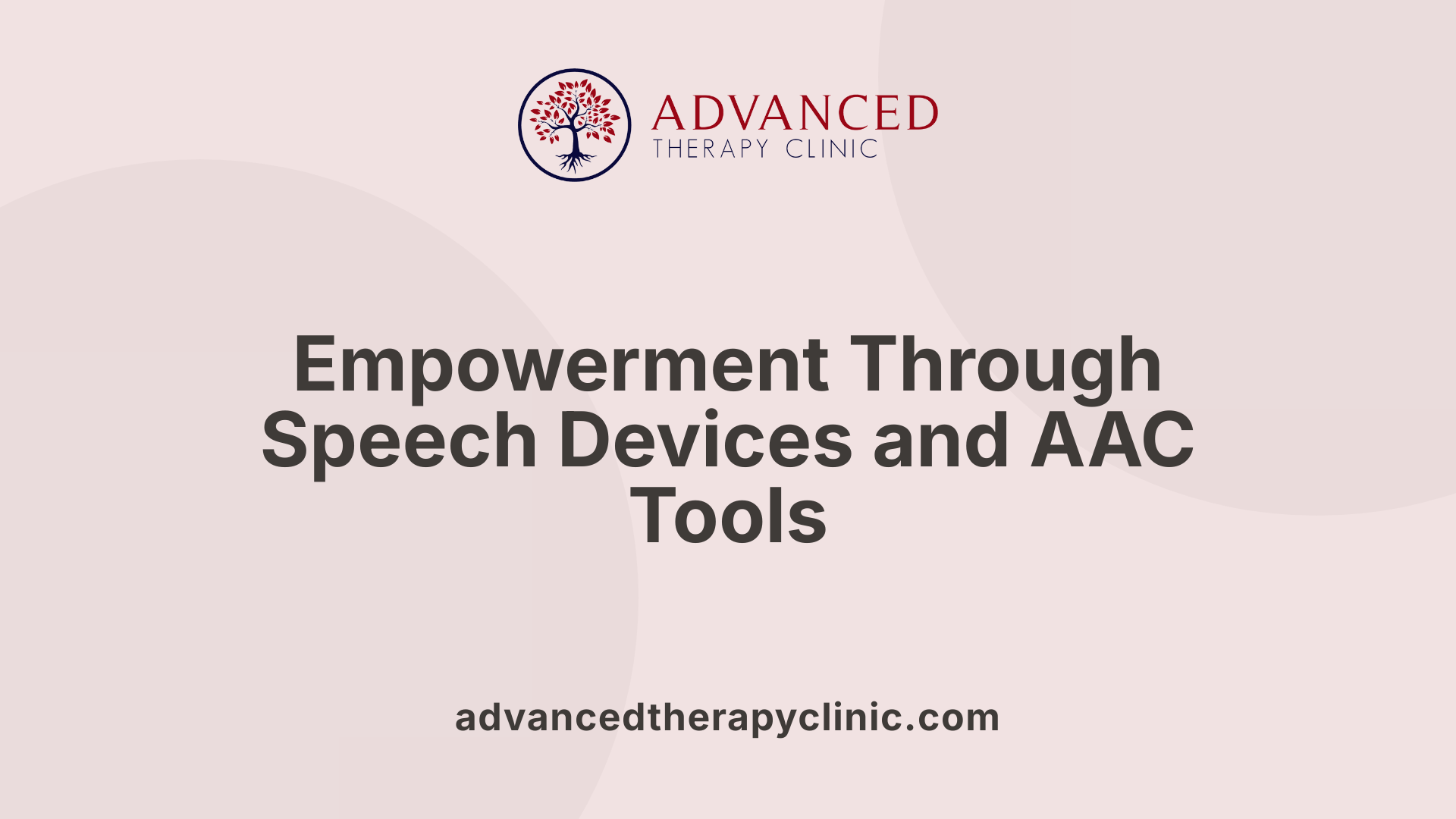The Role of Speech Devices in Building Self-Advocacy Skills


Unlocking Self-Advocacy Through Communication Tools
Speech devices and augmentative communication systems are transforming the landscape of self-advocacy for individuals with disabilities. By enhancing communication capabilities, these tools empower users to express their needs, make independent choices, and navigate social and educational environments confidently, leading to a greater sense of self-reliance and well-being.
The Critical Role of Speech Therapy in Developing Communication and Advocacy Skills
How does speech therapy impact communication, confidence, and assertiveness?
Speech therapy plays a vital role in improving communication abilities, which directly influences an individual's confidence and assertiveness. By addressing speech and language challenges, therapy helps individuals express their needs, opinions, and preferences more clearly. This not only enables more effective interactions but also fosters a sense of self-assurance. As individuals learn to communicate more effectively, they become more comfortable asserting themselves in social, educational, and workplace settings.
What strategies like goal-setting, role-playing, and self-reflection are used in therapy?
A variety of personalized strategies are incorporated into speech therapy sessions to bolster self-advocacy. Setting specific goals, such as improving communication in a particular context, helps target relevant skills. Role-playing exercises simulate real-life situations, allowing individuals to practice expressing their needs and practicing assertiveness in a safe environment. Self-reflection encourages self-awareness, helping individuals recognize their progress, understand their communication styles, and identify areas for improvement. These techniques together empower individuals to become more effective self-advocates.
Why is collaboration with speech-language pathologists and support systems essential?
Speech-language pathologists are central to supporting individuals on their journey to improved communication and self-advocacy. They tailor interventions to each person's unique needs, considering personal, cultural, and sensory factors. Collaboration with family members, educators, and other professionals ensures a comprehensive approach, creating a supportive environment that promotes continuous growth. Support systems like peer groups, community programs, and advocacy organizations further reinforce skills learned in therapy by providing opportunities to practice and apply new communication strategies in real-world situations.
What are the necessary communication skills for self-advocacy?
Effective self-advocacy hinges on certain communication skills. These include the ability to clearly articulate one's needs, feelings, and goals confidently and assertively. Active listening and questioning help ensure mutual understanding, fostering trust and respect. For neurodiverse individuals, employing alternative communication methods like AAC devices or customized strategies enhances both confidence and efficiency. Empathy, adaptability, and ongoing self-awareness through reflection are essential to refine advocacy efforts and build stronger, more effective communication. These skills collectively enable individuals to navigate social interactions, resolve conflicts, and seek support when needed, ultimately empowering them to take charge of their lives and well-being.
Enhancing Self-Advocacy Skills Through Practical Techniques Like Role-Playing

How can role-playing be used to practice self-advocacy skills?
Role-playing serves as a powerful tool for developing self-advocacy. It involves simulating real-world situations, such as communicating needs during a medical visit or requesting accommodations at school. This method allows individuals to rehearse their responses in a safe and controlled setting, which can significantly boost confidence.
Through repeated practice, participants learn to express their needs clearly and assertively. They also discover effective communication strategies and problem-solving techniques that are essential for advocacy.
Feedback from peers, family members, or facilitators during these exercises helps individuals understand their strengths and identify areas for improvement. This reflection encourages adaptive skills and promotes a growth mindset.
Addressing common advocacy challenges—like explaining sensory sensitivities or requesting specific support—is especially beneficial. Role-playing not only builds competence but also reduces anxiety associated with real-life advocacy efforts.
Overall, this technique enhances readiness and empowers individuals to confidently navigate social, educational, or healthcare settings to advocate effectively for themselves.
Setting Personalized Goals in Speech and Communication Development

What are some self-advocacy goals for speech language development?
Self-advocacy goals in speech and language development are centered on empowering individuals to communicate their needs, preferences, and challenges effectively. These goals often include improving specific communication skills, such as articulation clarity, fluency, and social language abilities like taking turns, initiating conversations, and expressing emotions.
Building self-confidence and assertiveness forms a significant part of these objectives. For example, a person might aim to speak up in group settings or ask for assistance when necessary. Strategies like role-playing social interactions, engaging in self-reflection to recognize communication strengths and areas for growth, and involving support systems such as family members, teachers, and speech-language pathologists are commonly used.
Creating goals that are personalized, measurable, and realistic is crucial. This ensures progress can be tracked and motivates individuals to take ownership over their communication development. By focusing on these tailored goals, individuals can better navigate social and educational situations, understand their rights, and advocate for needed accommodations.
Ultimately, developing self-advocacy skills through strategic goal-setting helps individuals communicate more confidently, make informed choices, and enhance their overall independence. This approach fosters a sense of agency, enabling individuals to effectively participate in various social, academic, and community environments.
Examples of Self-Advocacy in Daily Life and Systems Navigation

What are some self-advocacy examples for individuals with disabilities?
Self-advocacy plays a vital role in empowering individuals with disabilities to navigate various aspects of their lives confidently. One common example is requesting accommodations in workplaces and educational settings. For instance, a student with a learning disability might ask for extended test time or note-taking assistance, while an employee may request a quiet workspace or flexible hours to better manage their condition.
Understanding and asserting rights is another crucial aspect. This may involve advocating for necessary medical treatments, communicating challenges to caregivers, or asserting personal needs during interactions with service providers. By knowing their rights, individuals can make informed decisions about their healthcare and support services.
Participating in advocacy organizations or programs provides additional support and resources. Groups like The Arc or People First offer platforms for sharing experiences, gaining information, and learning how to effectively voice needs. Programs such as S.A.B.E. (Self-Advocacy Basic Education) help build confidence and skills in self-representation.
Developing these skills often includes learning about personal strengths and limitations, practicing positive self-talk, and seeking advice or resources to better understand options. Ultimately, these efforts help individuals express themselves clearly, make choices aligned with their preferences, and live more independent and fulfilling lives.
Enhancing self-advocacy not only improves daily functioning but also fosters a sense of autonomy and self-confidence, vital for personal growth and societal participation. Many resources and community networks are available to support this ongoing journey toward self-empowerment.
The Impact of Speech Devices and AAC Tools on Communication and Self-Empowerment

How do speech devices impact communication skills, problem-solving, and self-advocacy?
Speech devices, including speech-generating devices and communication boards, significantly boost an individual's ability to communicate effectively. These tools provide alternative means for expressing thoughts, needs, and emotions, making interactions more meaningful and reducing frustration.
Using AAC systems supports active participation in daily conversations, social outings, and decision-making processes. They also enhance problem-solving skills by offering dependable methods of communication when verbal speech is limited or unavailable. This independence in expressing oneself helps individuals navigate social and environmental challenges more effectively.
Furthermore, speech devices empower users to advocate for their rights, preferences, and services confidently. This self-advocacy is vital for achieving personal goals, accessing resources, and participating fully in society. Early training and system customization further improve communication, literacy, and social skills, reinforcing problem-solving and self-determination.
Overall, speech devices play a crucial role not only in improving communication but also in fostering independence and enhancing self-advocacy abilities.
What are the benefits of speech devices in fostering independence and confidence?
Speech devices and AAC tools serve as catalysts for greater independence. By enabling individuals to verbally or symbolically express their needs and choices, these tools lessen reliance on supporters and promote self-reliance.
Having reliable communication methods enhances social participation, strengthens personal relationships, and builds social confidence. When users successfully communicate, they often experience increased self-esteem and decreased anxiety, especially in unfamiliar or challenging situations.
Supporting autonomy, speech devices allow users to take part in daily activities, educational opportunities, and workplace interactions, boosting their sense of control over their lives. Emotional well-being improves as frustration diminishes and success in self-expression grows.
In essence, speech devices empower individuals to actively engage with their environment, make independent choices, and develop a stronger sense of self-assurance, contributing to overall life satisfaction and emotional resilience.
Overview of AAC tools and their effect on social participation and emotional well-being
| AAC Tool Type | Functionality | Impact on User's Life | Example Use |
|---|---|---|---|
| Speech-Generating Devices | Produces spoken output from user input | Facilitates verbal communication in social, educational, and work settings | Asking for help, participating in conversations |
| Communication Boards | Visual or tactile displays for selecting messages | Supports non-verbal or limited verbal users to express needs and wants | Indicating preferences or feelings |
| Sign Language | Manual communication system | Enhances social interaction and emotional bonding | Interacting with friends or family |
| Alternative Devices (e.g., tablets, smartphones with apps) | Multi-functional communication options | Provides versatile communication channels, including text and voice | Social media interaction, educational participation |
Customizing AAC approaches to fit personal preferences and contexts encourages more active dialogue, aids in building social networks, and improves emotional health. Recognizing each person's unique communication style and supporting their specific AAC tools fosters trust, independence, and a sense of belonging.
Fostering Empowerment and Autonomy Through Communication Tools
Incorporating speech devices and augmentative communication systems into the lives of individuals with disabilities is a transformative approach that significantly enhances their ability to advocate for themselves. These tools support the development of vital communication skills, boost confidence, and foster independence across social, educational, and workplace settings. Furthermore, combined with targeted therapy strategies like role-playing, self-reflection, and goal-setting, speech devices serve as powerful instruments for building resilience and self-determination. Supporting individuals in mastering their communication tools, while also providing systemic support and education, creates a more inclusive environment where everyone can participate actively and advocate effectively. Ultimately, empowering individuals through effective communication is a crucial step toward equitable participation and a more just society.
References
- Developing Self-Advocacy Skills: The Role of Speech Therapy
- The Role of a Speech Pathologist in Supporting Advocacy Skills
- Self-Advocacy: Empower Yourself to Speak Up - Thriveworks
- Building Self-Advocacy Skills in Individuals With Autism and ...
- Empowering Special Needs Students Through Self-Advocacy
- 5 Ways to Support Self-Advocacy in AAC Learners
- Self-Advocacy Skills: How TWC Helps Children Express Their Needs
- Strategies for helping people with speech disabilities advocate for ...
- Self-advocacy skills - CID Professional Development
Recent articles

Expressive Language Delay
Understanding the Challenges and Interventions for Children’s Speech Development

Is Lack Of Eye Contact An Autism Symptom?
Understanding the Role of Eye Contact in Autism Diagnosis and Behavior

Speech Fluency Tips
Mastering Speech Fluency: Essential Strategies and Resources

How Speech Therapy Assists with Storytelling and Narrative Development
Harnessing the Power of Narrative to Boost Language Skills

Camel Milk For Autism
Exploring the Therapeutic Potential of Camel Milk for Autism

The Benefits of Functional Communication Training in Behavior Analysis
Transforming Behavior Management: How FCT Enhances Communication and Reduces Challenges


